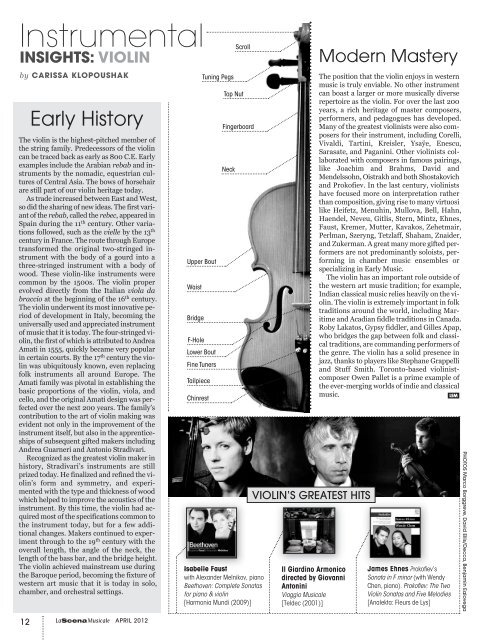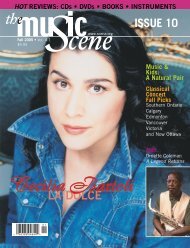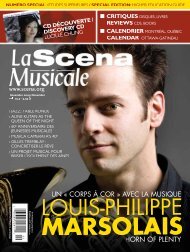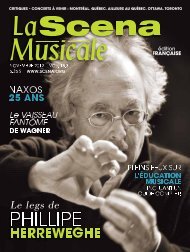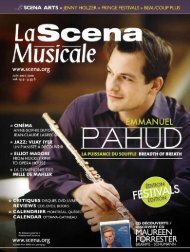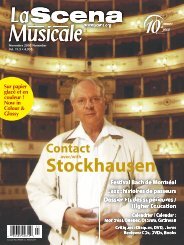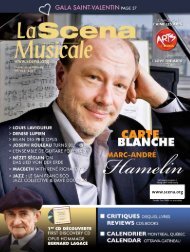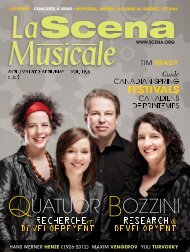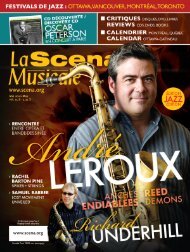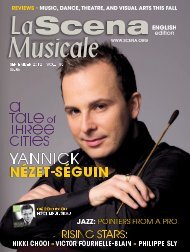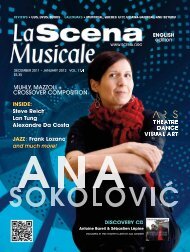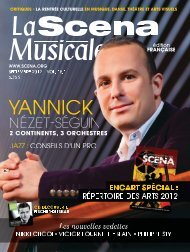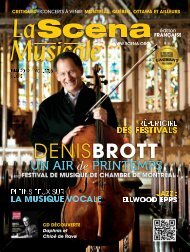The Bohlen-Pierce system - La Scena Musicale
The Bohlen-Pierce system - La Scena Musicale
The Bohlen-Pierce system - La Scena Musicale
You also want an ePaper? Increase the reach of your titles
YUMPU automatically turns print PDFs into web optimized ePapers that Google loves.
Instrumental<br />
INSIGHTS: VIOLIN<br />
by CARISSA KLOPOUSHAK<br />
Early History<br />
<strong>The</strong> violin is the highest-pitched member of<br />
the string family. Predecessors of the violin<br />
can be traced back as early as 800 C.E. Early<br />
examples include the Arabian rebab and instruments<br />
by the nomadic, equestrian cultures<br />
of Central Asia. <strong>The</strong> bows of horsehair<br />
are still part of our violin heritage today.<br />
As trade increased between East and West,<br />
so did the sharing of new ideas. <strong>The</strong> first variant<br />
of the rebab, called the rebec, appeared in<br />
Spain during the 11 th century. Other variations<br />
followed, such as the vielle by the 13 th<br />
century in France. <strong>The</strong> route through Europe<br />
transformed the original two-stringed instrument<br />
with the body of a gourd into a<br />
three-stringed instrument with a body of<br />
wood. <strong>The</strong>se violin-like instruments were<br />
common by the 1500s. <strong>The</strong> violin proper<br />
evolved directly from the Italian viola da<br />
braccio at the beginning of the 16 th century.<br />
<strong>The</strong> violin underwent its most innovative period<br />
of development in Italy, becoming the<br />
universally used and appreciated instrument<br />
of music that it is today. <strong>The</strong> four-stringed violin,<br />
the first of which is attributed to Andrea<br />
Amati in 1555, quickly became very popular<br />
in certain courts. By the 17 th century the violin<br />
was ubiquitously known, even replacing<br />
folk instruments all around Europe. <strong>The</strong><br />
Amati family was pivotal in establishing the<br />
basic proportions of the violin, viola, and<br />
cello, and the original Amati design was perfected<br />
over the next 200 years. <strong>The</strong> family’s<br />
contribution to the art of violin making was<br />
evident not only in the improvement of the<br />
instrument itself, but also in the apprenticeships<br />
of subsequent gifted makers including<br />
Andrea Guarneri and Antonio Stradivari.<br />
Recognized as the greatest violin maker in<br />
history, Stradivari’s instruments are still<br />
prized today. He finalized and refined the violin’s<br />
form and symmetry, and experimented<br />
with the type and thickness of wood<br />
which helped to improve the acoustics of the<br />
instrument. By this time, the violin had acquired<br />
most of the specifications common to<br />
the instrument today, but for a few additional<br />
changes. Makers continued to experiment<br />
through to the 19 th century with the<br />
overall length, the angle of the neck, the<br />
length of the bass bar, and the bridge height.<br />
<strong>The</strong> violin achieved mainstream use during<br />
the Baroque period, becoming the fixture of<br />
western art music that it is today in solo,<br />
chamber, and orchestral settings.<br />
Upper Bout<br />
Waist<br />
Bridge<br />
F-Hole<br />
Lower Bout<br />
Fine Tuners<br />
Tailpiece<br />
Chinrest<br />
Tuning Pegs<br />
Neck<br />
Scroll<br />
Top Nut<br />
Fingerboard<br />
Isabelle Faust<br />
with Alexander Melnikov, piano<br />
Beethoven: Complete Sonatas<br />
for piano & violin<br />
[Harmonia Mundi (2009)]<br />
VIOLIN’S GREATEST HITS<br />
Il Giardino Armonico<br />
directed by Giovanni<br />
Antonini<br />
Viaggio <strong>Musicale</strong><br />
[Teldec (2001)]<br />
Modern Mastery<br />
<strong>The</strong> position that the violin enjoys in western<br />
music is truly enviable. No other instrument<br />
can boast a larger or more musically diverse<br />
repertoire as the violin. For over the last 200<br />
years, a rich heritage of master composers,<br />
performers, and pedagogues has developed.<br />
Many of the greatest violinists were also composers<br />
for their instrument, including Corelli,<br />
Vivaldi, Tartini, Kreisler, Ysaÿe, Enescu,<br />
Sarasate, and Paganini. Other violinists collaborated<br />
with composers in famous pairings,<br />
like Joachim and Brahms, David and<br />
Mendelssohn, Oistrakh and both Shostakovich<br />
and Prokofiev. In the last century, violinists<br />
have focused more on interpretation rather<br />
than composition, giving rise to many virtuosi<br />
like Heifetz, Menuhin, Mullova, Bell, Hahn,<br />
Haendel, Neveu, Gitlis, Stern, Mintz, Ehnes,<br />
Faust, Kremer, Mutter, Kavakos, Zehetmair,<br />
Perlman, Szeryng, Tetzlaff, Shaham, Znaider,<br />
and Zukerman. A great many more gifted performers<br />
are not predominantly soloists, performing<br />
in chamber music ensembles or<br />
specializing in Early Music.<br />
<strong>The</strong> violin has an important role outside of<br />
the western art music tradition; for example,<br />
Indian classical music relies heavily on the violin.<br />
<strong>The</strong> violin is extremely important in folk<br />
traditions around the world, including Maritime<br />
and Acadian fiddle traditions in Canada.<br />
Roby <strong>La</strong>katos, Gypsy fiddler, and Gilles Apap,<br />
who bridges the gap between folk and classical<br />
traditions, are commanding performers of<br />
the genre. <strong>The</strong> violin has a solid presence in<br />
jazz, thanks to players like Stephane Grappelli<br />
and Stuff Smith. Toronto-based violinistcomposer<br />
Owen Pallet is a prime example of<br />
the ever-merging worlds of indie and classical<br />
music.<br />
LSM<br />
James Ehnes Prokofiev’s<br />
Sonata in F minor (with Wendy<br />
Chen, piano). Prokofiev: <strong>The</strong> Two<br />
Violin Sonatas and Five Melodies<br />
[Analekta: Fleurs de Lys]<br />
PHOTOS Marco Borggreve, David Ellis/Decca, Benjamin Ealovega<br />
12<br />
APRIL 2012


